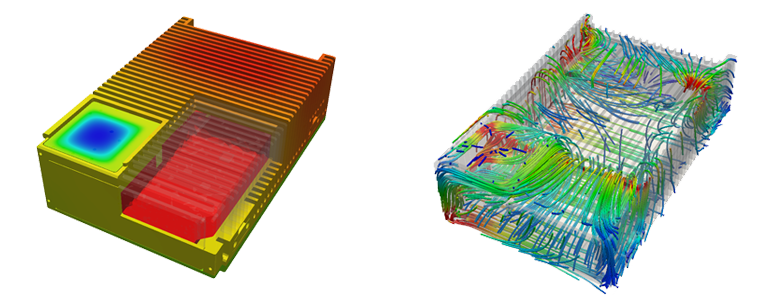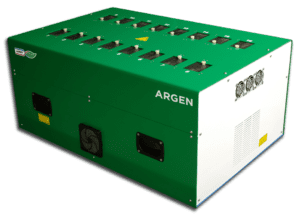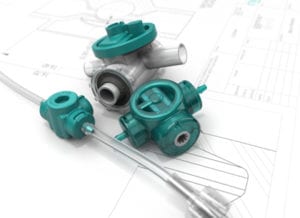
Founded in 1987 and based in Washington DC, QRC Technologies specializes in RF test and measurement products, especially for cellular communications. QRC develops and produces survey tools for cellular communication systems, phone-based measurement, simulation tools, forensic tools, and integrated RF recording and playback equipment.
An engineering project directed by David McCall, Senior Mechanical Engineer at QRC Technologies, was to design enclosures for RF testing equipment that measure cellular band signals and optimize heat dissipation.

RF testing tools can get hot—up to 50 °C (122 °F)—when relying on passive cooling alone. This became a big problem for QRC’s engineers when they relied on gut intuition and rule-of-thumb engineering to cool hard drives. Using only thermal pads between the hard drives and the boards was not enough. While having a good solution for the CPU, the hard drives were operating at their limit. The controller chip was hitting the physical limit and was shutting down as a defensive strategy to ensure nothing got damaged. While enclosures were getting smaller, there was a need to design a cooling system that would perform well in these specific conditions.
In total, we spent about a week on 4 iterations of the design, saving about 4 to 6 weeks time of work.

David McCall
Senior Mechanical Engineer QRC Technologies
When designing the interior of the casing, the team inserted heat sinks with copper slugs and graphite to give hard drives a heat path out to the enclosure. The choice of copper and graphite for the internal pieces was based on higher thermal conductivity, especially for thinner pieces, which enabled radiation effects to take place. The aim was to ensure heat could travel to the outer casing easier than it could travel through the air. With that in place, the enclosure would let off heat to the outer environment.
The final task was to ensure that the casing had sufficient surface area and an extra fan blowing onto it or get a case to radiate the heat out into the environment.
Before constructing any prototypes, thermal simulations were performed as the first line of defense to see if the chip would get too hot, or even break if it has no path for the heat to get out. QRC’s team went with the SimScale cloud-based CAE platform because it did not lock up resources locally. Another reason was cost, as SimScale had a competitive price compared to other software.
“It was also a lot more cost-effective as opposed to getting a seat and having it sit there for three to four months. We are a small company and might use a simulation for two solid weeks every six months—you can’t borrow that from a friend”, said David McCall. Our customer mostly used SimScale’s thermal analysis feature. He noted the thermal functions were powerful and broad, meeting his needs.

McCall’s team used simulations to test the orientation of the fins on one of their product’s enclosures. Several different CAD designs were investigated and used to improve the performance of the heat dissipation. This helped them avoid prototyping each of these designs since the simulation was already verified with the first prototype. This way, the team could find the right direction faster and cheaper. In total, McCall and the team spent about a week on 4 iterations of the design, saving about 4 to 6 week time.
The simulation data were verified and tested on a physical prototype as well. As QRC believes, all simulations, from any computer-aided engineering software, need to be taken with a grain of salt until the model is verified. McCall noted that the time used for simulations was definitely a week well spent, as one of the permutations of the design performed worse than the original. Thanks to the SimScale CAE platform, the team avoided expensive and long testing of an underperforming design.
The reason we went with SimScale is because it doesn’t lock up resources locally. I like the advantage of uploading the CAD into the cloud and running the simulation on someone else’s computer that we rent time on.
This case study was based on the article originally published on engineering.com and written by Shawn Wasserman, Simulation Editor. Edits were made by SimScale.






Sign up for SimScale
and start simulating now